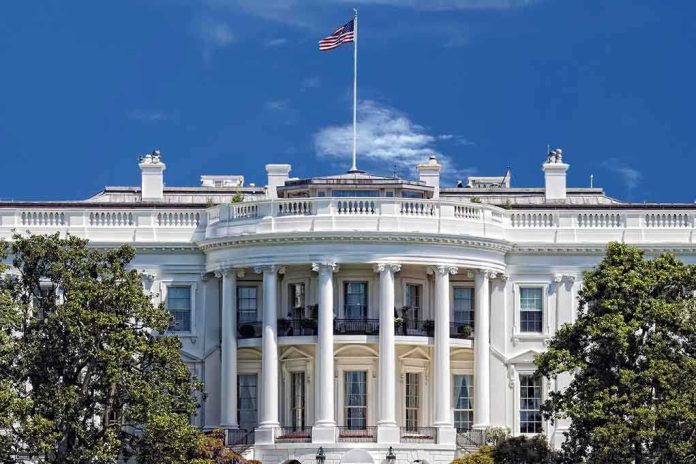
America’s most powerful house is now the site of a $300 million construction project—and not a single independent architect has a say in its design.
Story Snapshot
- The White House fired the entire Commission of Fine Arts, ending independent oversight of federal architecture in Washington, D.C.
- President Trump’s $300 million ballroom and monumental arch projects are moving forward without traditional review.
- This is the first time in modern history an entire commission overseeing federal design has been removed during a major project.
- Architects and preservationists warn of lasting consequences for transparency, historical preservation, and executive power.
Trump’s Ballroom Ambition and the Power Play Behind the Firings
President Trump’s vision for a grand $300 million ballroom at the White House has bulldozed its way through Washington’s architectural traditions. In late October 2025, as demolition crews tore into the East Wing, the administration abruptly fired all six members of the Commission of Fine Arts—the federal body charged with ensuring public buildings in the nation’s capital reflect American values and history. The commission’s removal was justified by the need for “America First” policies, a phrase signaling that loyalty to the president’s vision now trumps independent expertise and bipartisan practice. The ballroom project, along with the planned Independence Arch, is being pushed ahead with unprecedented speed, sidestepping the usual regulatory and consultation processes. The White House’s decision to clear out the CFA amounts to a seismic shift in how federal architecture is overseen, and the implications reach far beyond the latest construction site.
For more than a century, the CFA has quietly but powerfully shaped the look and feel of American democracy’s most visible buildings. Its members—architects, artists, and historians—have served presidents of both parties. They’ve debated designs for memorials, judged the aesthetics of federal buildings, and ensured that changes to the White House, Capitol, and other landmarks honor the past while serving the present. Until now, presidents have typically respected the commission’s independence, sometimes replacing individual members but never dismissing the entire panel. The sudden purge, coming as the East Wing faces the wrecking ball, sets a new precedent: When the executive wants to move fast and avoid dissent, tradition and oversight are dispensable.
Architectural Oversight vs. Presidential Legacy
The ballroom project is more than a renovation; it’s a statement. Trump’s approach echoes his private sector strategy—think big, move fast, and bend the rules if they stand in the way of a vision. Critics, including leading architects and preservationists, warn that sidelining the CFA undermines the public’s trust in how federal spaces are designed and maintained. Without independent review, decisions that shape the nation’s physical legacy rest solely in political hands. Supporters argue that a president has the right to appoint those who share his vision, and rapid transformation is sometimes needed to break bureaucratic gridlock. The clash is not simply about a ballroom or an arch; it’s about who gets to define American identity in stone, steel, and glass.
As the CFA’s office closes its doors and new members are promised—ones aligned with Trump’s priorities—Washington’s architectural community is left in limbo. The demolition continues, the ballroom’s construction is imminent, and debate rages in professional circles and on Capitol Hill. Preservationists see a threat to historical continuity and the risk of politicizing spaces meant to endure beyond any single administration. Some lawmakers warn that bypassing oversight could lead to legal challenges, delays, and public backlash. Others, frustrated by years of slow-moving bureaucracy, are quietly intrigued by the possibility of bold change.
Long-Term Consequences for Federal Design and Public Trust
The short-term fallout is already clear: the CFA’s absence disrupts established review processes, and construction moves forward with minimal outside input. The long-term stakes are higher. If future presidents follow Trump’s lead, independent oversight could become a relic, replaced by commissions of loyalists who rubber-stamp executive projects. The White House—an enduring symbol of American democracy—may change not just in appearance, but in the way its public spaces are conceived and protected. Architects and historians warn that the precedent set by these firings could erode the checks and balances that have safeguarded federal architecture for generations. The general public, meanwhile, faces the prospect of $300 million in taxpayer spending without the transparency and accountability that come with independent review.
In the weeks since the firings, expert commentary has centered on the tension between legacy and process. Supporters of the president’s move point to the need for decisive leadership and the right to appoint commission members who share the administration’s goals. Detractors argue that the loss of independent oversight risks turning federal space into political spectacle, rather than public heritage. The impact on the architectural and preservationist communities is profound, but the consequences for American governance and civic trust may prove even more lasting. The story is still unfolding, with new appointments on the horizon and construction racing ahead. Whether this marks the beginning of a new era in federal design or a cautionary tale of executive overreach remains an open question.
Sources:
YouTube: Trump fires members of commission that would have reviewed …












